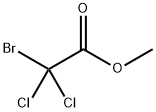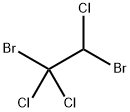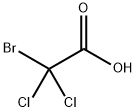BROMODICHLOROMETHANE
Synonym(s):Dichlorobromomethane
- CAS NO.:75-27-4
- Empirical Formula: CHBrCl2
- Molecular Weight: 163.83
- MDL number: MFCD00000824
- EINECS: 200-856-7
- SAFETY DATA SHEET (SDS)
- Update Date: 2024-12-18 14:07:02

What is BROMODICHLOROMETHANE?
Description
Bromodichloromethane is a liquid. Molecularweight=163.8; Specific gravity (H2O:1)=1.98; Boilingpoint=90℃. Odor threshold=about 1675 mg/m3. Solublein water.
Chemical properties
Bromodichloromethane (BDCM) is a colorless, heavy, non-burnable/non-flammable liquid. It was formerly used as a flame retardant, a solvent for fats and waxes and because of its high density for mineral separation. Now, it is only used as a reagent or intermediate in organic chemistry. Small amounts of BDCM are also made in chemical plants for use in laboratories or in making other chemicals. On contact with hot surfaces or flames, BDMC decomposes forming toxic and corrosive gases, including hydrogen bromide and hydrogen chloride and reacts with strong bases, strong oxidants, and magnesium. BDMC is found in chlorinated drinking water as a consequence of the reaction between chlorine, added during water treatme
Chemical properties
clear colorless to yellowish liquid
The Uses of BROMODICHLOROMETHANE
A volatile halogenated methane present in trace amounts in drinking water as a result of the water treatment process. It is also present in swimming pools due to chlorination and can be used as tracers to identify water leaks. It is useful as chain transfer agents in PVC polymerization.
The Uses of BROMODICHLOROMETHANE
Chemical reagent, intermediate in organic synthesis.
The Uses of BROMODICHLOROMETHANE
As a chemical intermediate for organic synthesis and as a laboratory reagent; formerly used as a solvent and flame retardant. Currently, the major source of bromodichloromethane in the environment is from its formation as a by-product during chlorination of water.
Definition
ChEBI: A one-carbon compound that is methane substituted by a bromo and two chloro groups. It occurs as a contaminant in drinking water.
Synthesis Reference(s)
Tetrahedron Letters, 28, p. 2769, 1987 DOI: 10.1016/S0040-4039(00)96205-1
General Description
Clear colorless liquid.
Air & Water Reactions
Slightly water soluble.
Reactivity Profile
BROMODICHLOROMETHANE may react with strong bases and magnesium. Incompatible with oxidizing materials .
Health Hazard
SYMPTOMS: Symptoms of exposure to BROMODICHLOROMETHANE may include irritation of the skin, eyes, mucous membranes and respiratory tract. It may also cause narcosis. Other symptoms may include nausea, dizziness and headache. It may also cause liver and kidney damage. Central nervous system effects may also occur.
Health Hazard
On ingestion, BDMC causes damage to the kidneys, liver, and impaired functio
Fire Hazard
Literature sources indicate that BROMODICHLOROMETHANE is nonflammable.
Biochem/physiol Actions
Bromodichloromethane (BDCM) induces steatohepatitic injury in human liver. BDCM induces the cell proliferation in different tissues and kidney damage by renal tuble cell proliferation in male F344 rats.
Safety Profile
Confirmed carcinogen with experimental carcinogenic data. Moderately toxic by ingestion. Human mutation data reported. When heated to decomposition it emits very toxic fumes of Brand Cl-. See also CHLORINATED HYDROCARBONS, ALIPHATIC; and BROMIDES.
Potential Exposure
This compound may find applicationin organic synthesis.
First aid
If this chemical gets into the eyes, remove anycontact lenses at once and irrigate immediately for at least15 min, occasionally lifting upper and lower lids. Seekmedical attention immediately. If this chemical contactsthe skin, remove contaminated clothing and wash immediately with soap and water. Seek medical attention immediately. If this chemical has been inhaled, remove fromexposure, begin rescue breathing (using universal precautions, including resuscitation mask) if breathing hasstopped and CPR if heart action has stopped. Transferpromptly to a medical facility. When this chemical hasbeen swallowed, get medical attention. Give large quantities of water and induce vomiting. Do not make an unconscious person vomit.
Carcinogenicity
Bromodichloromethane is reasonably anticipated to be a human carcinogen based on sufficient evidence of carcinogenicity from studies in experimental animals.
Source
MCLG: zero; MCL: 0.08 mg/L. Total for all trihalomethanes
cannot exceed a concentration of 0.08 mg/L. In addition, a DWEL of 700 μg/L was recommended
(U.S. EPA, 2000).
By-product in chlorination of drinking water and use of fire extinguishers (quoted,
Verschueren, 1983).
Environmental Fate
Biological. Bromodichloromethane showed significant degradation with gradual adaptation in a
static-culture flask-screening test (settled domestic wastewater inoculum) conducted at 25 °C. At
concentrations of 5 and 10 mg/L, percent losses after 4 wk of incubation were 59 and 51,
respectively. At a substrate concentration of 5 mg/L, 8% was lost due to volatilization after 10 d
(Tabak et al., 1981).
Chemical/Physical. The estimated hydrolysis half-life in water at 25 °C and pH 7 is 137 yr
(Mabey and Mill, 1978). Reported products of hydrolysis include carbon monoxide, hydrochloric
and hydrobromic acids (Ellington et al., 1993; Kollig, 1993).
At influent concentrations of 1.0, 0.1, 0.01, and 0.001 mg/L, the GAC adsorption capacities at
pH 5.3 were 7.9, 1.9, 0.47, and 0.12 mg/g, respectively (Dobbs and Cohen, 1980).
storage
Color Code—Blue: Health Hazard/Poison: Storein a secure poison location. Prior to working with thischemical you should be trained on its proper handling andstorage. Store in a refrigerated space in a tightly closedcontainer. Protect from light. A regulated, marked areashould be established where this chemical is handled,used, or stored in compliance with OSHA Standard1910.1045.
Shipping
Toxic, liquids, organic, n.o.s. requires a shippinglabel of “POISONOUS/TOXIC MATERIALS.” It falls intoHazard Class 6.1 and Packing Group III.
Properties of BROMODICHLOROMETHANE
| Melting point: | −55 °C(lit.) |
| Boiling point: | 87 °C(lit.) |
| Density | 1.98 g/mL at 25 °C(lit.) |
| vapor pressure | 50 at 20 °C (Dreisbach, 1952) |
| refractive index | n |
| Flash point: | 87-89°C |
| storage temp. | 2-8°C |
| solubility | water: insoluble |
| form | neat |
| color | Clear, colorless liquid |
| Water Solubility | 3.032g/L(30 ºC) |
| Merck | 14,1417 |
| BRN | 1697005 |
| Henry's Law Constant | In seawater (salinity 30.4‰): 5.52, 10.51, and 18.97 at 0, 10, and 20 °C, respectively (Moore et
al., 1995) |
| Stability: | Light Sensitive, Volatile |
| CAS DataBase Reference | 75-27-4(CAS DataBase Reference) |
| IARC | 2B (Vol. 52, 71) 1999 |
| EPA Substance Registry System | Dichlorobromomethane (75-27-4) |
Safety information for BROMODICHLOROMETHANE
| Signal word | Danger |
| Pictogram(s) |
 Corrosion Corrosives GHS05  Exclamation Mark Irritant GHS07  Health Hazard GHS08 |
| GHS Hazard Statements |
H302:Acute toxicity,oral H315:Skin corrosion/irritation H318:Serious eye damage/eye irritation H335:Specific target organ toxicity, single exposure;Respiratory tract irritation H351:Carcinogenicity |
| Precautionary Statement Codes |
P201:Obtain special instructions before use. P280:Wear protective gloves/protective clothing/eye protection/face protection. P302+P352:IF ON SKIN: wash with plenty of soap and water. P308+P313:IF exposed or concerned: Get medical advice/attention. |
Computed Descriptors for BROMODICHLOROMETHANE
New Products
(S)-3-Aminobutanenitrile hydrochloride 4-Methylphenylacetic acid N-Boc-D-alaninol N-BOC-D/L-ALANINOL Tert-butyl bis(2-chloroethyl)carbamate 3-Morpholino-1-(4-nitrophenyl)-5,6-dihydropyridin- 2(1H)-one Furan-2,5-Dicarboxylic Acid Tropic acid 1-Bromo-3,5-Di-Tert-Butylbenzene S-2-CHLORO PROPIONIC ACID ETHYL ISOCYANOACETATE 2-Bromo-1,3-Bis(Dimethylamino)Trimethinium Hexafluorophosphate 4-IODO BENZOIC ACID 3-NITRO-2-METHYL ANILINE 1-(2,4-DICHLOROPHENYL) ETHANAMINE (2-Hydroxyphenyl)acetonitrile 4-Bromopyrazole 2-(Cyanocyclohexyl)acetic acid 4-methoxy-3,5-dinitropyridine 1-(4-(aminomethyl)benzyl)urea hydrochloride 2-aminopropyl benzoate hydrochloride diethyl 2-(2-((tertbutoxycarbonyl)amino) ethyl)malonate tert-butyl 4- (ureidomethyl)benzylcarbamate Ethyl-2-chloro((4-methoxyphenyl)hydrazono)acetateRelated products of tetrahydrofuran








You may like
-
 Bromodichloromethane (stabilized with Ethanol) CAS 75-27-4View Details
Bromodichloromethane (stabilized with Ethanol) CAS 75-27-4View Details
75-27-4 -
 2033-24-1 98%View Details
2033-24-1 98%View Details
2033-24-1 -
 1975-50-4 98%View Details
1975-50-4 98%View Details
1975-50-4 -
 2-HYDROXY BENZYL ALCOHOL 98%View Details
2-HYDROXY BENZYL ALCOHOL 98%View Details
90-01-7 -
 2-Chloro-1,3-Bis(Dimethylamino)Trimethinium Hexafluorophosphate 221615-75-4 98%View Details
2-Chloro-1,3-Bis(Dimethylamino)Trimethinium Hexafluorophosphate 221615-75-4 98%View Details
221615-75-4 -
 61397-56-6 CIS BROMO BENZOATE 98%View Details
61397-56-6 CIS BROMO BENZOATE 98%View Details
61397-56-6 -
 14714-50-2 (2-Hydroxyphenyl)acetonitrile 98+View Details
14714-50-2 (2-Hydroxyphenyl)acetonitrile 98+View Details
14714-50-2 -
 118753-70-1 98+View Details
118753-70-1 98+View Details
118753-70-1